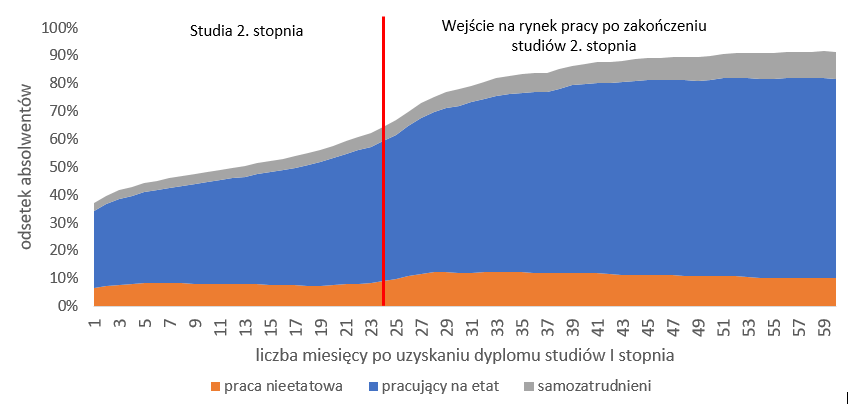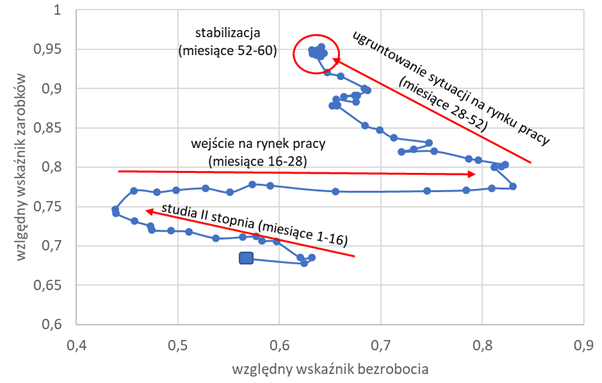
In general, graduates of 1st cycle studies choose to continue their education by pursuing 2nd cycle studies. After graduation, a significant proportion also acquire their first professional experience – some are already employed just after graduation. After 2nd cycle studies, professional activity of graduates increases significantly: five years after graduation over 90% of them work, and the risk of unemployment for this group of employees as well as their earnings become more stable.
The completion of the first full cycle of economic situation tracking for graduates of 1st cycle studies indicates that most of the graduates continue their studies (during the first year after graduation, more than half of the graduates undertake 2nd cycle studies). At the same time, a large proportion of 1st cycle graduates are able to gain experience on the labour market. For over 30% of them this means working full-time. The increase in the professional activity is clear 24 months after obtaining a 1st cycle studies diploma, i.e. after completing 2nd cycle studies.
Following graduation, as time passes, the share of people with work experience goes up to 90% and more. Five years after graduation, 72% of former students work full-time. However, 26-30 months after their 1st cycle studies (i.e. after completing 2nd cycle studies) most young graduates do not work full-time, but rather on a contractual basis (e.g. delivering jobs on the basis of contracts of mandate and other contracts). Subsequently, the part-time percentage starts to decrease significantly, giving way to full-time work. Over time, the cohort of self-employed graduates grows at a steady pace: five years after graduation, 10% of those who completed their 1st cycle studies in 2014 were self-employed, compared to just 3% immediately after obtaining a diploma.
Percentage of working graduates of 1st cycle studies in the 2014 graduate cohort, split by employment type
Entering job market after completing 2nd cycle studies
 Źródło: dane z systemu ELA
Źródło: dane z systemu ELA
It is also interesting to track the evolution of earnings and the risk of unemployment among the graduates. After obtaining a 1st cycle diploma, the earnings of the graduates amount to about 2/3 of the average salary in their poviats of residence, and the risk of unemployment is almost half that of their local (poviat) labour markets. Within a year and a half after graduation we can observe a decrease in the risk of unemployment and a gradual increase in earnings to about 75% of the average earnings in the poviats of residence of the graduates. The next stage (16-28 months after graduation) is when the graduates enter the labour market - while their level of earnings becomes more stable, it is also accompanied by a growing risk of unemployment, as more and more of the graduates start to seek jobs. However, we must bear in mind that in the group of 1st cycle graduates, three years after their graduation about a half of them obtained another diploma. Those who did not undertake further studies (following their 1st cycle studies) may slightly inflate the unemployment rate. Over the following two years after graduation (months 28-52), the situation of the graduates in the labour market becomes increasingly stable: their risk of unemployment decreases, and the relative level of earnings increases. Therefore, after a little more than 4 years after obtaining their 1st cycle diploma, the situation of the graduates in the labour market stabilises, both in terms of their earnings and the threat of unemployment.
The graphical representation of the relative unemployment rate and the relative earnings rate of the 2014 cohort of graduates of 1st cycle studies, over 5 years following graduation.
 Source: data from the ELA system
Source: data from the ELA system